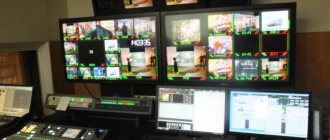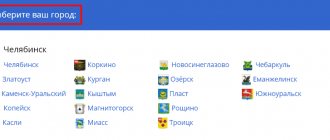When does analog TV stop in St. Petersburg?
According to the schedule, the transition from analogue to digital signal was carried out on February 11, 2021, April 15, 2021 and June 3, 2021. The supply of analogue broadcasting will be completely stopped in St. Petersburg and the Leningrad region on October 14, 2021. What are the benefits of watching digital channels:
- Twenty public digital channels in high quality are becoming free for all residents of Russia.
Based on an analog signal, this is impossible due to the high cost of its modernization and maintenance. An analog signal has a limited radio frequency resource. - For many Russians, the transition to new broadcasting means an end to information inequality and the opportunity to watch programs in high quality picture and sound.
- Transmitting a digital signal reduces the power of transmitters while increasing the signal's resistance to interference.
- Viewers have the opportunity to record programs for later viewing.
- And the main advantage is the complete absence of a subscription fee. Free viewing of the main public channels.
List of digital TV frequencies for setting up TVs and set-top boxes
| № | frequency, kHz | Modulation | Symbol rate, MS/s |
| 1 | 386000 (SK30) | 256 QAM | 6750 |
| 2 | 394000 (SK31) | 256 QAM | 6750 |
| 3 | 402000 (SK32) | 256 QAM | 6750 |
| 4 | 410000 (SK33) | 256 QAM | 6750 |
| 5 | 418000 (SK34) | 256 QAM | 6750 |
| 6 | 426000 (SK35) | 256 QAM | 6750 |
| 7 | 434000 (SK36) | 256 QAM | 6750 |
| 8 | 442000 (SK37) | 256 QAM | 6750 |
| 9 | 554000 (31TVK) | 256 QAM | 6750 |
| 10 | 546000 (30TVK) | 256 QAM | 6750 |
| 11 | 562000 (32TVK) | 256 QAM | 6750 |
| 12 | 570000 (33TVK) | 256 QAM | 6750 |
| 13 | 578000 (34TVK) | 256 QAM | 6750 |
| 14 | 610000 (38TVK) | 256 QAM | 6750 |
| 15 | 618000 (39TVK) | 256 QAM | 6750 |
| 16 | 634000 (41TVK) | 256 QAM | 6750 |
| 17 | 642000 (42TVK) | 256 QAM | 6750 |
Connecting to a new type of broadcasting standard DVB-T2
Recommendations for connecting digital television were approved by the Government of the Russian Federation by Order No. 287-r and by the decision of the State Commission dated March 16, 2012.
The digital signal in Russia is carried out in the DVB-T2 format. The DVB-T2 standard is one of the latest generations of the European type of broadcasting terrestrial television DVB-T. In this standard, the capacity of terrestrial television networks is increased by 30 percent.
To connect digital broadcasting, no special skills or knowledge are required . Setting up equipment to receive the signal will not take much time.
Digital television frequencies in Moscow and the Moscow region
In the capital and region, as expected, the frequency grid of digital broadcasting practically coincides with the approved one:
- first multiplex - 546 MHz (channel 30);
- second multiplex - 498 MHz (24th channel);
- the third multiplex is 578 MHz (channel 34).
I would like to note that the third multiplex was not officially launched even in this region. It is broadcast in testing mode according to a specific schedule, and if in the capital itself, in areas located near transmission towers, reception is quite reliable, then in remote regions of Moscow and the region there is virtually no reception.
What you need for this: equipment
New TVs released after 2012 receive a new signal with an antenna. The antenna can be of internal or external type. The antenna can also be collective or individual. TVs manufactured after 2012 have a built-in DVB-T2 tuner that allows you to receive a digital signal.
- On a device with a built-in tuner, you can configure 10 or 20 digital public channels through auto channel search.
- For television receivers in which the DVB-T2 tuner is not initially built-in, you will need, in addition to the antenna, to connect a digital receiver. The set-top box will decode the signal for transmission to the TV.
- Ancient Soviet televisions will not be able to receive this signal, even with the help of additional equipment. An additional set-top box is connected via a tulip connector, which is not available on Soviet TVs.
How to connect it?
Many companies offer services for connecting additional equipment for broadcast reception. But anyone can set up the antenna and set-top box by following step-by-step instructions.
Antenna installation and configuration
- Please read the instructions carefully before installation.
- Check the location and procedure for connecting the antenna to the television receiver.
Don't forget to purchase a cable with characteristic impedance. Recommended value 75 Ohm. - Find out where the nearest tower is located and point the antenna in that direction.
- Using auto tuning, start searching for channels. If the channels are not tuned in, start manual tuning.
- You can adjust the signal quality level by rotating the antenna.
Focus on the signal intensity and quality scale.
What can be done if the antenna signal is not stable:
- First, check to see if there were any short-term signal outages.
- If your neighbors have a digital signal, check your device's connections - antenna and cable.
- If no one has a signal, report the information to the hotline. Temporary problems may occur.
If the image is blurry, check that the amplifier on the antenna is turned on. Near a tower, having the amplifier turned on may reduce or change the picture quality due to the strong antenna signal. It is necessary to turn off the amplifier or reduce the gain slightly.
Do not install antennas of unknown manufacture; purchase them only with technical documents.
How to install the console?
- Before installing the set-top box, disconnect the TV from the network.
- Connect the antenna to the set-top box.
- Insert the cable into the audio and video connectors on the set-top box and TV set.
- Connect the equipment to the network and turn it on.
- Select the input signal type from the TV menu. The signal source can be designated as HDMI, AV, SCART.
- Use auto tuning to search for channels. If you are unable to configure the channels, start manual tuning.
Please refer to the instruction manual.
How to set your TV to digital?
To configure your TV to digital, you should consider the basic circuit for all TV receivers. In different models and from different manufacturers, the sequence of actions and names of setting items may differ.
Basic algorithm:
- Enter the TV menu using the remote control.
- Select "Options" - "Auto setup".
- Signal source – “Cable”.
- Click “Start”.
- Source: Digital.
- Click “Start”.
- In the “Search Mode” item, select “Full”.
When connecting digital TV in St. Petersburg, you should remember that there are TV models that require additional cable search parameters. In this case, enter:
- Frequency (kiloHertz) - 314,000 (314 MHz).
- Modulation - 256 QAM.
- Transmission speeds - 6875 kS/s.
Tuning your TV to a new broadcast will not cause problems if you follow the product operating instructions.
Frequencies of DVB-T2 digital channels
| TVK | Frequency, MHz |
| 21 | 474 |
| 22 | 482 |
| 23 | 490 |
| 24 | 498 |
| 25 | 506 |
| 26 | 514 |
| 27 | 522 |
| 28 | 530 |
| 29 | 538 |
| 30 | 546 |
| 31 | 554 |
| 32 | 562 |
| 33 | 570 |
| 34 | 578 |
| 35 | 586 |
| 36 | 594 |
| 37 | 602 |
| 38 | 610 |
| 39 | 618 |
| 40 | 626 |
| 41 | 634 |
| 42 | 642 |
| 43 | 650 |
| 44 | 658 |
| 45 | 666 |
| 46 | 674 |
| 47 | 682 |
| 48 | 690 |
| 49 | 698 |
| 50 | 706 |
| 51 | 714 |
| 52 | 722 |
| 53 | 730 |
| 54 | 738 |
| 55 | 746 |
| 56 | 754 |
| 57 | 762 |
| 58 | 770 |
| 59 | 778 |
| 60 | 786 |
| 61 | 794 |
| 62 | 802 |
| 63 | 810 |
| 64 | 818 |
| 65 | 826 |
| 66 | 834 |
| 67 | 842 |
| 68 | 850 |
| 69 | 858 |
Frequency table for the northern capital and Leningrad region
Let's look at what frequencies the new type of broadcasting operates in St. Petersburg. The tables provide a complete list of 20 broadcasting channels in St. Petersburg and the Leningrad region. For convenience, the television channel number and its frequency are indicated.
First Multiplex
| Name | TVK number and frequency (MHz) |
| First channel | №35 (586) |
| Russia 1 | №35 (586) |
| Match TV | 35 (586) |
| NTV | 35 (586) |
| Channel 5 | 35 (586) |
| Russia K | 35 (586) |
| Russia 24 | 35 (586) |
| Carousel | 35 (586) |
| OTR | 35 (586) |
| TV Center | 35 (586) |
Second Multiplex
| Name | TVK number and frequency (MHz) |
| Ren TV | 45 (666) |
| Saved | 45 (666) |
| STS | 45 (666) |
| Home | 45 (666) |
| TV-3 | 45 (666) |
| Friday | 45 (666) |
| Star | 45 (666) |
| World | 45 (666) |
| TNT | 45 (666) |
| Muz TV | 45 (666) |
Third multiplex (RTRS-3)
Operates in test mode in Moscow and the Moscow region. About 40 channels. Broadcasts on frequency 578.
| TV channel | Frequency, MHz | Broadcasting time, h/week |
| Sports 1 | 578 | Around the clock |
| Sports 2 | 578 | 00:00-06:00 (42) |
| Fight club | 578 | 06:00-12:00 (42) |
| My planet | 578 | 12:00-18:00 (42) |
| Science 2.0 | 578 | 18:00-00:00 (42) |
| Russian novel | 578 | 00:00-05:00 (35) |
| Russian bestseller | 578 | 05:00-10:00 (35) |
| Russian detective | 578 | 10:00-15:00 (35) |
| Story | 578 | 15:00-20:00 (35) |
| Cartoon | 578 | 20:00-00:00 (35) |
| Sundress | 578 | 00:00-12:00 (84) |
| A country | 578 | 12:00-00:00 (84) |
| Living Planet | 578 | 00:00-06:00 (42) |
| IQ HD (SD quality) | 578 | 06:00-09:00 (21) |
| 24 Doc | 578 | 09:00-12:00 (21) |
| Techno 24 | 578 | 12:00-15:00 (21) |
| Mother | 578 | 15:00-18:00 (21) |
| NST | 578 | 18:00-21:00 (21) |
| Amusement park | 578 | 21:00-00:00 (21) |
| Moscow. Confidence | 578 | 00:00-12:00 (84) |
| euronews | 578 | 12:00-00:00 (84) |
| Music of the First | 578 | 08:30-01:30 (119) |
| Home Cinema | 578 | 01:30-02:30 (7) |
| Time | 578 | 02:30-04:30 (14) |
| TV cafe | 578 | 04:30-06:30 (14) |
| Beaver | 578 | 06:30-08:30 (14) |
| 365 days of TV | 578 | 00:00-02:00 (14) |
| TNT-Comedy | 578 | 02:00-04:00 (14) |
| Lots of TV | 578 | 04:00-06:00 (14) |
| HD Life (SD quality) | 578 | 06:00-08:00 (14) |
| STV | 578 | 08:00-10:00 (14) |
| India TV | 578 | 10:00-12:00 (14) |
| Fighter | 578 | 12:00-14:00 (14) |
| Comedy TV | 578 | 14:00-16:00 (14) |
| La Minor | 578 | 16:00-18:00 (14) |
| Men's cinema | 578 | 18:00-20:00 (14) |
| Kitchen TV | 578 | 20:00-22:00 (14) |
| Auto Plus | 578 | 22:00-00:00 (14) |
| LifeNews | 578 | Around the clock |
| Our football | 578 | Blocked |
How many programs will be available in St. Petersburg for free: complete list
20 federal channels become available and free for every resident of the Russian Federation.
First multiplex:
- First channel.
- Russia is one.
- NTV.
- Match TV.
- Channel 5.
- Russia K.
- Russia 24.
- OTR.
- Carousel.
- TV Center
Second multiplex:
- Ren TV.
- STS.
- Saved.
- Home.
- TV-3.
- Friday.
- Star.
- World.
- TNT.
- Muz TV.
This is public television in DVB-T2 format.
There is another option for high definition television. This is digital cable television. Cable television is also provided if the TV can receive a DVB-T2 signal. If digital broadcasting allows you to watch 20 publicly available channels, then cable broadcasting allows you to watch about 200. The list of channels on cable broadcasting is constantly growing.
By cost in St. Petersburg and the Leningrad region:
- Terrestrial television costs approximately 150 rubles per month for using a public antenna provided by Rostelecom.
- Using cable television will cost approximately 200 rubles per month. In this case, the number of channels will be many times higher.
When connecting to cable television, you can refuse to use the Rostelecom communal antenna. To do this, you need to write an application at any office of the company.
Digital television
The digital format of broadcasting television channels in the modern world is becoming increasingly widespread. Typically this is DVB (Digital Video Broadcasting) digital broadcasting, used in terrestrial, cable, and satellite television systems. In this case, TVs can receive channels using their built-in tuner of the appropriate standard, or using a set-top box - a receiver capable of receiving the required standard. DVB receivers can be purchased at hardware stores. For over-the-air channels, DVB-T and DVB-T2 broadcasting standards are currently used. For cable DVB-C and DVB-C2.
Digital television can be implemented interactively and broadcast by Internet providers over network channels (IPTV). In such cases, the organizers provide their subscribers with special IPTV-SetTopBox set-top boxes, connected to televisions using external digital (HDMI, DVI) or analog (SCART, RCA) connections.
Terrestrial digital broadcasting in St. Petersburg
Since 2012, digital broadcasting of television programs in the DVB-T2 standard has been carried out in test mode in St. Petersburg and the region. Two channels (multiplexes) are used, operating at UHF frequencies for free broadcasting in digital format of television programs of domestic television companies.
In St. Petersburg, the Multiplex-1 digital package is broadcast at a frequency of 586 MHz (UHF channel 35) providing the transmission of the following programs: Channel One (ORT), Channel Five (St. Petersburg), Russia 1, Russia K (Culture), Russia 2, Russia 24, NTV, TV Center, OTR (Public Television of Russia), Karusel... Changes and additions are possible.
The Multiplex-2 package is broadcast at a frequency of 666 MHz (UHF channel 45) with the following programs: STS, TNT, REN-TV, MUZ-TV, Sports, MIR, Star, Home... Changes and additions are possible.
Regional repeaters can transmit the above packages on other UHF frequencies, so to detect them you need to use the search for digital channels in the settings menu of your TV or set-top box (receiver).
Unfortunately, currently the reception of digital terrestrial channels is limited by the technical capabilities of televisions capable of receiving in the DVB-T2 standard. Only some of the latest TV models from well-known manufacturers, such as Samsung, LG, Sony, Panasonic, Philips, Toshiba, Sharp, Thomson, Grundig, Shivaki..., provide such a technical capability. When purchasing a TV, you need to check its ability to support DVB-T2.
Samsung TV models with DVB-T2 tuner:
UE22F5000, UE22F5400, UE22F5410, UE32EH5007KXRU, UE32EH5047KXRU, UE32EH5057KXRU, UE32EH5307KXRU, UE32F5000, UE32F5020, UE32F6330, UE32F640 0, UE32EH6037KXRU, UE32ES5507KXRU, UE32ES5537KXRU, UE32ES5557KXRU, UE32ES6307UXRU, UE32ES6547UXRU, UE32ES6557UXRU, UE32ES6717UXRU, UE32ES6727UXRU, UE32ES6757MX RU, UE37ES6307UXRU, UE37EH5007KXRU, UE37ES6710, UE39F5000, UE39F5020, UE40EH5007KXRU, UE40EH5047KXRU, UE40EH5057KXRU, UE40EH5307KXRU, UE40F6400, UE40F6330, UE40F6650, UE40EH6037KXRU, UE40ES5507KXRU, UE40ES5537KXRU, UE40ES5557KXRU, UE40ES6307UXRU, UE40ES6547UXRU, UE40ES6557UXRU, UE40ES6577UXRU, UE40ES6727UXRU, UE40ES6757MXRU, UE40ES6857MXRU, UE40ES6907UXRU, UE40 ES7207UXRU, UE40ES7507UXRU, UE40ES8007UXRU, UE42F5000, UE42F5020, PS43E497B2KXRU, PS43F4900, UE46F5000, UE46F5020, UE46EH5007KXRU, UE46EH5047KXRU, UE46EH5057KXRU, UE46EH5307KXRU, UE46EH6037KXRU, UE46ES5507KXRU , UE46ES5537KXRU, UE46ES5557KXRU, UE46ES6307UXRU, UE46F6400, UE46F6330, UE46ES6547UXRU, UE46ES6557UXRU, UE46ES6577UXRU, UE46ES6727UXRU, UE46ES6757MXRU, UE46ES6 857MXRU, UE46ES6907UXRU, UE46ES7005UXRU, UE46ES7207UXRU, UE46ES7507UXRU, UE46ES8007UXRU, UE50ES5507KXRU, UE50ES6715KXRU, UE50ES6907UXRU, PS51E497B2KXRU, PS51F4900, PS51E537A3KXRU, PS51E557D1KXRU, PS51E6507EUXRU, PS51E8007GUXRU, UE 55ES6307UXRU, UE55F6400, UE55ES6547UXRU, UE55ES6557UXRU, UE55ES6577UXRU, UE55ES6857MXRU, UE55ES6907UXRU, UE55ES7507UXRU, UE55ES8007UXRU, PS60E557D1KXRU, PS60E6500 EUXRU, PS60E6507EUXRU, PS64D8000, PS64E8007GUXRU, UE65ES8005UXRU, UE65ES8007UXRU, UE65F6400, UE75ES9000, UE75ES9007, …
LG TV models with DVB-T2 tuner:
M2252T, M2352T, DM2352T, M2452T, M2752T, DM2752T, 32LA620V, 32LA644V, 32LA660V, 32LS345T, 32LS350T, 32LS359T, 32LS560T, 32LS561T, 32LS562T , 32LN540V, 32LN541U, 32LM340T, 32LS570T, 32LM580T, 32LM585T, 32LM620T, 32LM640T, 32LM660T, 32LM669T, 37LS560T, 37LN540V, 37LN541U, 39LM620T, 39LN540V, 42CS460T, 42PA4510, 42LA620V, 42LA660V, 42LA644V, 42LA690V, 42LA741V, 42LS340T, 42LS 345T, 42LS560T, 42LS561T, 42LS562T, 42LM340T, 42LS570T, 42LN540V, 42LM580T, 42LM585T, 42LM615T, 42LM620T, 42LM625T, 42LM640T, 42LM660T, 42LM669T, 42LM670T, 42LM760T, 42LM761T, 42LM860V, 42LN540V, 47LS560T, 47LS561T, 47LS562T, 47LA620V, 47LA644V, 47LA66 0V, 47LA690V, 47LA741V, 47LA860V, 47LN540V, 47LM580T, 47LM585T, 47LM640T, 47LM620T, 47LM660T, 47LM669T, 47LM670T, 47LM760T. 47LM761T, 47LM860V, 47LM960V, 50LA620V, 50LA644V, 50LN540V, 50PZ850, 50PN650T, 50PM470T, 55LA620V, 55LA660V, 55LA690V, 55LA741V, 55LA86 0V, 55LM620T, 55LM625T, 55LM640T, 55LM660T, 55LM670T, 55LM760T, 55LM761S, 55LM761T, 55ML860V, 55ML960V, 60LA860V, 65LM620T, 72LM950V. 84LM9600, 84LM960V, …
Sony TV models with DVB-T2 tuner:
KDL-22EX553, KDL-26EX553, KDL-32EX653, KDL-32EX343, KDL-32HX753, KDL-32HX755, KDL-32EX343, KDL-32R423A, KDL-32R424A, KDL-32W603A, KDL-32W653A, KDL-40EX65 3, KDL- 40HX753, KDL-40HX755, KDL-40HX853, KDL-40HX855, KDL-40R473A, KDL-40R474A, KDL-42EX443, KDL-42W653A, KDL-42W807A, KDL-42W808A, KDL-46EX653, KDL-46EX6 53, KDL-46HX753, KDL-46HX755, KDL-46HX853, KDL-46HX855, KDL-46R473A, KDL-47W807A, KDL-47W808A, KDL-55HX753, KDL-55HX755, KDL-55HX853, KDL-55HX855, KDL-55HX923, KDL- 55HX953, KDL- 55HX955, KDL-55NX723, KDL-55W807A, KDL-55W808A, KDL-65HX923, KDL-65HX925, KDL-65HX953, KDL-65HX955, KDL-84X9005, …
Panasonic TV models with DVB-T2 tuner:
TX-LR32ET5W, TX-LR32ET5, TX-PR42GT50, TX-PR42ST50, TX-PR42UT50, TX-PR42XT50, TX-LR42DT50, TX-LR42E5, TX-LR47DT50, TX-PR50VT50, TX-PR50GT50, TX-PR50ST50, TX- PR50UT50, TX-PR50XT50, TX-PR55VT50, TX-PR55ST50, TX-LR55WT50, TX-LR55ET5, TX-P65ST50, TX-P(R)60ZT60, TX-PR65VT50, …
Philips TV models with DVB-T2 tuner:
19PFL3507T, 22PFL3507T, 22PFL3517T, 24PFL3507T, 32PFL5007T, 32PFL5008T, 32PFL4007T, 32PFL5507T, 32PFL6007T, 32PFL6008T, 32PFL3008T, 32 PFL3507T, 32PFL3517T, 32PFL3206T, 32PFL3208T, 32PFL3258T, 32PFL6008T, 32PFL6087T, 32PFL7607T, 37PFL3507T, 37PFL6606T, 39PFL4208T, 40PFL31 08T, 40PFL5507T, 40PFL5537T, 40PFL5007T, 40PFL5527T, 40PFL6606T, 40PFL7007T, 40PFL8007T, 40PFL8008S, 40PFL8606T, 42PFL3507T, 42PFL3507T, 42PFL3208T, 42PDL6907T, 42 PFL4007T, 42PFL4307T, 42PFL5008T, 42PFL5028T, 42PFL5038T, 42PFL6007T, 42PFL6057T, 42PFL6097T, 42PFL6877T, 42PFL6907T, 42PFL7108S, 42PFL74 06T, 42PFL7606T, 46PFL4208T, 46PFL9706T, 46PFL9707T, 46PFL5507T, 46PFL5537T, 46PFL3807T, 46PFL5527T, 46PFL6606T, 46PFL7007T, 46PFL8007T, 46PFL8008S, 46PFL8606T, 46 PFL9707S, 47PFL4007T, 47PFL4307T, 47PFL5008T, 47PFL6007T, 47PFL6057T, 47PFL6097T, 47PFL6877T, 47PDL6907T, 47PDL7008S, 47PFL7108S, 47PDL76 06T, 47PDL7666T, 50PFL7956T, 52PFL9606T, 55PFL5507T, 55PFL5527T, 55PFL5537T, 55PFL6007T, 55PFL6008S, 55PFL6606T, 55PFL7007T, 55PFL7008S, 55PFL7108S, 55PFL7606T, 55 PFL8007T, 55PFL8008S, 58PFL9956T, 60PFL9607S, 60PFL9607T, …
Toshiba TV models with DVB-T2 tuner:
22L1353, 22L1354, 32RL953, 32RL955, 32TL963, 32ML963, 40RL953R, 40RL955R, 40TL963R, 40ML963, 42VL963, 46TL963R, 46ML963, 47VL963, 55V L963, 55ZL2, …
Sharp TV models with DVB-T2 tuner:
LC-60LE636, LC-60LE741, LC-60LE841, LC-70LE836, LC-70LE741, LC-80LE632, LC-80LE633, LC-80LE646, …
Thomson TV models with DVB-T2 tuner:
T32E53DU, T40E53DHU, T40E53HU, T42E53DHU, …
Grundig TV models with DVB-T2 tuner:
22 Vle 7120 BF, 26 Vle 7200 BR, 26 Vle 7200 WR, 32 Vle 7230 BR, 32 Vle 7230 WR, 32 Vle 9230 BR, 32 Vle 9270 BR, 37 Vle 9270 BR, 40 Fle 9270 BR, 40 Fle 9270 SR, 40 Vle 8270 BR, 40 Vle 8270 WR, 40 Vle 7230 BR, 40 Vle 7230 WR, 42 Vle 9270 BR, 46 Fle 9270 SR, 46 Fle 9270 BR, 46 Vle 8270 BR, 46 Vle 8270 WR, 46 Vle 7230 BR, 46 VLE 7230 WR, 47 VLE 9270 BR, 55 FLE 9270 SR, 55 FLE 9270 BR, 55 VLE 9270 BR, …
Shivaki TV models with DVB-T2 tuner:
STV-22LED3, STV-24LED3, STV-24LEDGR9, STV-24LEDG9, STV-24LEDVDGW9, STV-26LED3, STV-26ALED3, …
TV repair in St. Petersburg
How to switch to 57 Rostelecom programs?
Rostelecom informed its subscribers about the open access of 57 digital channels.
From November 1, 2021, Rostelecom subscribers can receive 57 broadcast channels on their devices. All Rostelecom digital channels are broadcast at no additional cost. The broadcast is carried out through a cable previously laid in a residential area . No additional equipment is required. All you need is retuning on all TVs in the apartment.
The TV receiver must accept the DVB-C standard.
- Select Cable channels from the menu.
- Launch "Auto Setup".
- Select "Cable TV/DVB-C".
- Operator Rostelecom.
- Select Digital.
Specify - skip encrypted programs. - Click "Get Started."
If all actions are performed correctly, 57 digital television channels should be tuned in.
Free help from specialists
If the digital signal has not been configured, then after turning off the analog channels, a message will appear on their frequency indicating the need to connect a new broadcast.
- If you have questions when connecting digital broadcasting, or when selecting and setting up additional equipment, you can call the toll-free hotline number: 8-800-220-2002. Specialists can provide assistance around the clock.
- Consultation can be given by calling 081 for operators Rostelecom, Megafon, Tele 2 or by calling the regional hotline 246-80-81.
- You can contact the Consulting Support Center of the St. Petersburg branch of RTRS: e-mail
- Frequently asked questions and answers on the topic of digital television are discussed on the official website of RTRS.RF in the “For TV Viewers” section.
- More detailed information on how to set up digital channels yourself can be read on the website SMOTRICIFRU.RF.
After considering the benefits of digital television, it becomes clear that the digital signal is the future of television broadcasting. By following the instructions and simple tips, anyone can set up broadcasting digital channels on their TV without the help of specialists.
map.rtrs.rf:
02/23/2018 at 06:42
Gennady Panev, media: “Scattered, understaffed local television studios cannot create good content”
02/14/2018 > 17:01 Author: Derik Alexey
It is not easy for a municipal canal to exist without legislative assistance from the state.
But in the Leningrad region, the group has been successfully developing for several years, proving by its example that local television still has a future.
Gennady Panev, chairman of the board of directors of the Oreol media group, told Tele-Sputnik what ideas made it possible to achieve self-sufficiency and constant expansion of the network of news offices.
The Oreol media group is an association of municipal-level television studios from a number of cities in the Leningrad region.
Each of them individually cannot provide 24 hours of its own broadcasting, so the common channel is formed by the studios jointly.
❓ Have the principles of organizing your channel’s broadcasts changed over the past couple of years?
Almost none, although in recent years we have increased the number of broadcasting cities and gained new experience.
We just put even more emphasis on local news.
Starting in the spring of 2021, our broadcasting schedule has changed.
If earlier we broadcast city news in turn in the second quarter of every hour, now we additionally began to repeat local news in the fourth quarter of every hour.
There is no news only from 20:00 to 21:00. At this time, there are live broadcasts on Tuesdays and Thursdays.
On other days of the week, prepared original programs are broadcast at this evening hour.
We continue to give each studio the opportunity to make changes to the broadcast schedule, discussing this at the editorial council, which meets via Skype every Tuesday.
The only thing that remains unchanged is the news release in the second quarter of each hour.
In addition, we strengthened the composition and equipment of the central group, which took upon itself the issues and problems of covering events at the regional level.
❓ Do you have purchased content on air?
Hardly ever. We are not able to buy expensive films and programs.
In addition, in order to avoid copyright issues, we only show films from the “national treasure” category.
They are popular, especially among older viewers.
I always tell my staff that we are local television.
We must reflect the events and life of a given municipality or the Leningrad region as a whole.
Therefore, between the news there is material that we prepare ourselves.
For example, the television studio is located in Ivangorod, it has material related to military reconstruction from the times of chivalry or the period of the Great Patriotic War - it’s not for nothing that the fortresses of Narva and Ivangorod are nearby.
We take this content and show it throughout the Leningrad region.
In Tikhvin there is an icon of the Mother of God, in Podporozhye and Lodeynoye Pole there are Vepsians, Luga is the land of partisan glory.
Each city has its own peculiarity.
And if the Literature and Cinema festival is held in Gatchina, we film the opening and closing ceremonies, gala concerts, and throughout the festival we work with artists and directors who came to the city, telling and showing how they live, where they go, where they communicate with people.
We didn't have anyone. We film exclusive material that will not appear on federal channels.
❓ Do you manage to make money from advertising? Are federal channels your competitors?
In the current economic conditions, advertisers who work with local channels will never go to federal and regional ones.
Their wallet size is different. They are not able to pay huge amounts of money per second on a federal or regional channel. Yes, they don’t need it.
Having the opportunity to provide information to a part of the Leningrad region, more than 50% of whose territory is covered by the Oreol media group, we often encounter advertisers who want to limit the broadcast of videos, for example, to a certain city or part of cities.
“But in the neighboring city, on the contrary, I don’t need to be seen - I have strong competitors there, they will act against me if they see that I am starting an active advertising campaign,” they say.
Even such nuances occur, what can we say about federal advertising?
❓ Can your approach be replicated to other regions?
Our experience is completely replicable.
When I talked about it at various events, listeners were amazed: after all, this is an extremely simple way to create a 24-hour TV broadcasting channel on a regional scale, combining the efforts and capabilities of individual municipal studios, which can provide material for a limited time per day.
The idea is on the surface. And the fact that it is tenacious is proven by our very existence.
Literally at the end of 2021, we registered another enterprise in another city in the Leningrad region, which, with our participation, joins the media group.
We are able to organize not only information and news broadcasting.
For example, our project “We Remember” at the media forum of the allied states of Russia - Belarus took 2nd place, losing only to the Gomel company, that is, in fact, we became the first in Russia.
❓ And what is the secret?
A little is needed here - good will and understanding of municipal-level studios.
We need unification, and, I emphasize, on the terms of good will. The most difficult moment is psychological.
People must have the desire to meet and talk to each other.
But everyone is used to being the boss in their own “kiosk.”
But the time of the “kiosk” business has already passed.
In the Leningrad region, on the initiative of the government, the third monitoring of all media was carried out, which quite predictably showed that television, newspapers and radio are losing ratings - the audience is moving to the Internet.
But this does not mean that newspapers, radio and television will completely disappear in the coming years.
However, the trend must be taken into account. The economics of media life are not changing for the better.
Under these conditions, representatives of the government of the Leningrad region recommend joining forces.
And I agree with them. We must try to unite - we can no longer live as before, when all the work in a local studio could be done by 2-3 people.
❓ What has changed?
First of all, scattered, understaffed local TV studios cannot create good content - it is simply unrealistic.
And if the content is bad, the TV channel’s attractiveness will be much lower than that of its colleagues, and you won’t make money from it.
And the question arises, where to find these 2-3 people.
One of the main problems is the severe shortage of personnel, especially in the outback.
Global cities - Moscow, St. Petersburg, Yekaterinburg and Vladivostok - are simply sucking people out of the provinces like a vacuum cleaner.
And higher education now, as it sometimes seems, produces not specialists, but diploma certificates.
Therefore, it is very difficult to find qualified personnel at the local level.
In this case, joining forces, creating joint content, and mutual assistance is the only way out.
The very existence of 2, and somewhere even 3 TV studios at the municipal level in a city with a population of about 100 thousand residents is simply nonsense both from the point of view of the economy and public awareness, if each TV studio has limited economic and human resources.
As an example: not so long ago there was the birthday of the Leningrad region.
This is an interesting festive event with a good program, summing up the activities and so on.
Due to the fact that we are a media group, three television crews worked there.
I myself watched from the sidelines and received absolute pleasure when I saw how employees in the vests of the Oreol media group were filming the most interesting moments in different places and from different positions.
What separate municipal studio can deploy 3-4 television crews for such events with a common presenter, radio communication, an agreed plan of action, organized logistics, and the like?
And they worked successfully for us.
In addition, each of the teams - and I gathered them from different cities of the media group - paid special attention to its delegation, for example, to speaking and awarding people from their municipal area.
As a result, we got, on the one hand, good regional content, and on the other hand, high-quality individual content for a specific municipality.
❓ Is it possible for a municipal-level channel to make money on the Internet? Is your media group conquering the vastness of the World Wide Web?
Of course we are going there.
We have created groups on social networks, we have a website, however, we cannot relaunch it.
I am dissatisfied that it is not working as actively as I would like, but to make a good website, you need to have a start-up capital of at least 100 thousand rubles, as well as a budget for its maintenance.
However, even without restarting the site, we are actively working in this direction.
Statistics showed an interesting thing: from city to city, people in the Leningrad region use the Internet differently.
Where cable networks are present only in the city and do not cover nearby villages, the number of clicks on our stories is higher, because people in villages and towns do not have the opportunity to watch local cable television, and terrestrial TV is not available everywhere.
That's why they watch us on the Internet.
We have now decided that news should always end with a “bow”: at the end of a 15-minute news broadcast, the presenter must say which of the stories in the previous episode earned the most views.
At the same time, pictures from that news and the text are given: “See us on such and such a site, in such and such a VKontakte group.” That is, we immediately provide a link to online stories.
❓ What do you think about the 22nd button initiative?
Since they say (although this can now be taken as a joke) that the media are the fourth estate, television should to some extent replicate the structure of power.
We have 3 levels of government: federal, regional and local.
Similarly, television media should be at the federal, regional and local levels.
This was implemented earlier, under socialism, when one selected newspaper or television company in each municipality received appropriate preferences, grants and support.
However, any support must be provided in such a way that it is not divorced from the realities of life at every level.
Since today Moscow largely lives its own life, and the outback lives its own, I would not want any support measures to be “stillborn.”
In recent years, very often decisions made with fanfare are canceled because they do not work.
But the strangest thing is that no one bears any responsibility for this. And this is really starting to irritate society.
❓ Do you think that there may be any difficulties associated with this legislative initiative?
There is at least one nuance here: at the municipal level there may be more than one television company.
For example, in the Leningrad region there are cities where several television studios operate, and they can even be broadcast on different cable networks.
The question of which of them to assign the status of the 22nd button with the corresponding obligations and rights may have different shades, even corruption.
It is necessary to define clear selection criteria, but it often happens that the state sets some limits, and then the entire community, relatively speaking, stands on its heels, trying to comply with them. An excellent example is the “Yarovaya Law”.
To pass such laws or establish any criteria, you must first think through everything carefully.
It is useful to “consult with the community” that will implement these regulations.
❓ Doesn’t the community participate in the dialogue on the 22nd button?
So far we have not heard any questions or proposals.
What kind of dialogue can there be if there is no information about what this dialogue should be in principle?
I and other people who work, as they say, closer to the people, at a low - municipal - level, are always surprised that there are no representatives of such businesses where such decisions are made.
For example, advisory bodies have now been created under the Ministry of Telecom and Mass Communications of the Russian Federation and other government agencies, but only representatives of large globalist companies are present there.
Of course, they will make decisions taking into account only their own interests.
And in their understanding, we are a trifle that “gets in the way.”
It is clear that everything is moving towards globalization, uniting into corporations.
But we must not forget that any state consists not only of those who live in the capital.
There are also cities of medium and small level, where people also live who have their own characteristics, opportunities and interests.
And there are more such people in Russia than in the capital and cities with a population of over a million.
Answer










